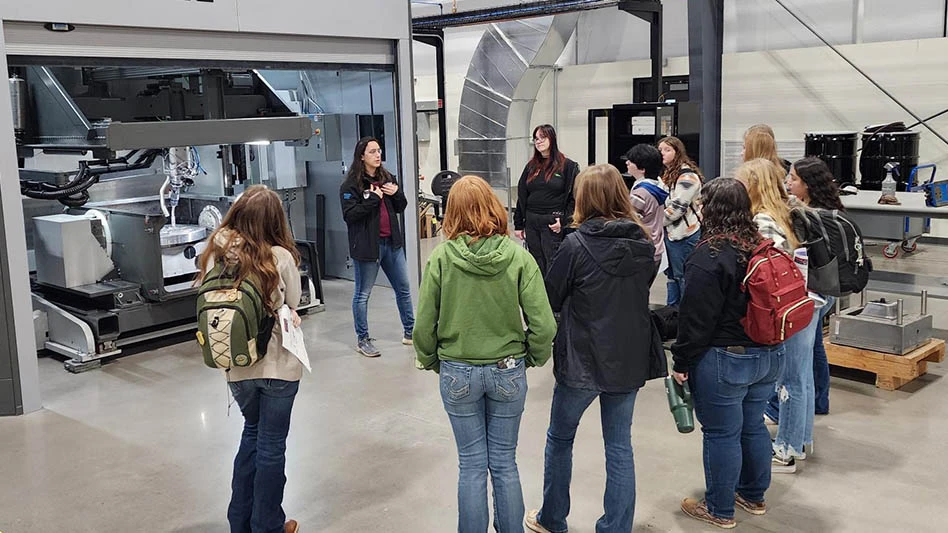
Thanks to some high-tech wizardry developed by engineers at the Massachusetts Institute of Technology (MIT) and NASA, a new kind of bendable, morphing wing architecture could simplify manufacturing and reduce fuel consumption by improving the wing’s aerodynamics and agility. The design is based on a system of tiny, lightweight subunits that could be assembled by small, specialized robots. The wing would be covered by a skin made of overlapping pieces that might resemble scales or feathers, allowing for the pieces to move across each other as the wing flexes, while still providing a smooth outer surface.
The new concept is described in the journal Soft Robotics, in a paper by Neil Gershenfeld, director of MIT’s Center for Bits and Atoms (CBA); Benjamin Jenett, a CBA graduate student; Kenneth Cheung Ph.D., a CBA alumnus and NASA research scientist; and others.
Researchers have been trying for many years to achieve a reliable way of deforming wings as a substitute for the conventional, separate, moving surfaces, but all those efforts “have had little practical impact,” Gershenfeld says. The biggest problem was that most of these attempts relied on deforming the wing using mechanical control structures within the wing, but these structures tended to be so heavy that they canceled out any efficiency advantages produced by the smoother aerodynamic surfaces. They also added complexity and reliability issues.
By contrast, Gershenfeld says, “We make the whole wing the mechanism. It’s not something we put into the wing.” In the team’s new approach, the whole shape of the wing can be changed, and twisted uniformly along its length, by activating two small motors that apply a twisting pressure to each wingtip.
Like building blocks
The basic principle behind the new concept is the use of an array of tiny, lightweight structural pieces, which Gershenfeld calls “digital materials,” that can be assembled into a virtually infinite variety of shapes, much like assembling a structure from Lego blocks.
The individual pieces are strong and stiff, but the exact choice of the dimensions and materials used for the pieces, and the geometry of how they are assembled, allow for a precise tuning of the flexibility of the final shape.
Building up a large and complex structure from an array of small, identical building blocks, which combine strength, light weight, and flexibility, greatly simplifies the manufacturing process, Gershenfeld explains. While the construction of light composite wings for today’s aircraft requires large, specialized equipment for layering and hardening the material, the new modular structures could be rapidly manufactured in mass quantities and then assembled robotically in place.Saving fuel, cutting emissions
Considering airline economics and the desire to reduce greenhouse gas emissions, even small improvements in fuel efficiency could be significant. Wind-tunnel tests of the structure showed that it at least matches the aerodynamic properties of a conventional wing, at about 1/10 the weight.
When it’s no longer needed, the whole structure can be taken apart and its components reassembled into something completely different. Similarly, repairs could be made by replacing an area of damaged subunits.
“An inspection robot could just find where the broken part is and replace it, and keep the aircraft 100% healthy at all times,” says Jenett.
MIT

Explore the March 2017 Issue
Check out more from this issue and find your next story to read.
Latest from Aerospace Manufacturing and Design
- Season's greetings
- 2024 Favorites: #7 Article – Deep drawing aerospace components
- 2024 Favorites: #7 News – GKN Aerospace completes sale of St. Louis facility to Boeing
- 2024 Favorites: #8 Article – Beyond uptime
- 2024 Favorites: #8 News – NASA, Lockheed Martin reveal X-59
- 2024 Favorites: #9 Article – 5 tips for upskilling your aerospace machinists
- 2024 Favorites: #9 News – Siemens acquires Altair Engineering
- 2024 Favorites: #10 Article – How 3D-printed aviation parts can accelerate return to air





